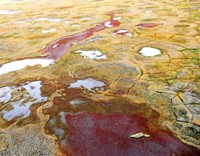Advertisement
Grab your lab coat. Let's get started
Welcome!
Welcome!
Create an account below to get 6 C&EN articles per month, receive newsletters and more - all free.
It seems this is your first time logging in online. Please enter the following information to continue.
As an ACS member you automatically get access to this site. All we need is few more details to create your reading experience.
Not you? Sign in with a different account.
Not you? Sign in with a different account.
ERROR 1
ERROR 1
ERROR 2
ERROR 2
ERROR 2
ERROR 2
ERROR 2
Password and Confirm password must match.
If you have an ACS member number, please enter it here so we can link this account to your membership. (optional)
ERROR 2
ACS values your privacy. By submitting your information, you are gaining access to C&EN and subscribing to our weekly newsletter. We use the information you provide to make your reading experience better, and we will never sell your data to third party members.
Environment
No Progress On Nitrate Runoff
Water: Flow of pollutant into the Gulf of Mexico is up 9% since 1980
by Sara Peach
August 15, 2011
| A version of this story appeared in
Volume 89, Issue 33

Despite decades of effort to reduce pollution in the Mississippi River Basin, nitrate levels haven’t improved since 1980, according to a study from the U.S. Geological Survey (Environ. Sci. Technol., DOI:10.1021/es201221s).
Nitrogen and phosphorus fertilizer washes into groundwater and rivers that make up the Mississippi River Basin. Eventually this pollution makes its way into the Gulf of Mexico, where it feeds a dead zone, an area of low-oxygen water where many organisms cannot survive.
But evaluating the effectiveness of policies to shrink the zone is difficult, says Lori A. Sprague, a USGS researcher. Weather variations, such as rainfall, cause year-to-year fluctuations in the amount of pollutants flowing into rivers, complicating analysis of runoff trends.
Sprague and her colleagues used a statistical method to control for weather variations. The researchers analyzed data collected by USGS between 1980 and 2008 from eight sites on the Mississippi and its tributaries.
The researchers found that at sites on three tributaries, nitrate pollution had not changed. Meanwhile, pollution increased by as much as 75% at five sites in the basin. Overall, they determined that the amount of nitrate flowing through the basin into the Gulf increased by 9%.
of the University of Illinois, Urbana-Champaign, says the researchers’ method is a boon for studying trends in nitrate pollution.
But the trends they found are disappointing, he says: “We’ve been trying to address this problem for quite some time, and it doesn’t look like we’re making any progress.”





Join the conversation
Contact the reporter
Submit a Letter to the Editor for publication
Engage with us on Twitter